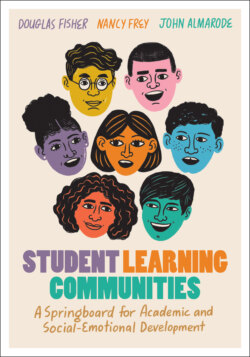Student Learning Communities

Реклама. ООО «ЛитРес», ИНН: 7719571260.
Оглавление
Нэнси Фрей. Student Learning Communities
Student Learning Communities
Table of Contents
Why Student Learning Communities Matter
The Principles of Learning Communities
Figure 1.1. The Parallel Conditions for Successful PLCs and SLCs
Student Learning Communities as the Means to Improve Student Learning
Figure 1.2. The Process of Learning in Student Learning Communities
Moving Forward …
Tasks and Experiences That Encourage Student Dialogue
Attending to Language
Why Student Talk Matters in Learning
Facilitating Discourse for Learning
Figure 2.1. Purposeful Student Talk Within the Gradual Release of Responsibility Instructional Framework
Focused Instruction
Guided Instruction
Collaborative Learning
Independent Learning
A Checklist for SLC Task Design
Mobilize the Skills of Individuals for the Collective Benefit
Plan for Productive Failure
Ensure Tasks Are Challenging
Identify Opportunities for Motivation
Foster Group Cohesion
Require Positive Interdependence
Task Design in Action
Figure 2.2. A Task Designed to Promote Collaborative Learning
Task Transformation
Figure 2.3. Transforming Tasks
Moving Forward …
Supportive Relational Conditions That Empower Learning
Modeling Desired Ways of Relating and Interacting
The Biology of Learning
The Classroom Implications
Using Knowledge Emotions to Build Learning Pathways
Surprise
Interest
Confusion
Awe
Social Sensitivity and Social Cohesion
Figure 3.1. Guided Personal Interview Task
Providing Intentional Support for Peer Relationships
Engineering the Classroom Environment
Promote interaction through flexible seating
Figure 3.2. Project Collaboration on a Virtual Huddle Board
Promote interaction through visual support
Figure 3.3. Language of Learning Poster
Moving Forward …
Shared Agreements About Success
Figure 4.1. Individual Content Learning Intentions and Success Criteria
Figure 4.2. Individual Content Learning Intentions and Success Criteria Plus SLC Success Criteria
The Case for Success Criteria
Goal Setting
Linking Individual Goals to Group Goals
Progress Monitoring
Charting Performance Data
Using Success Criteria to Self-Assess
Figure 4.3. Success Criteria Self-Assessment for Medieval Japan Unit
Providing Time to Reach Shared Agreements
Using Norms as Overarching Success Criteria
Moving Forward …
Intentional Collective Learning
Team Cognition
Team Metacognition
Team Reflection
Figure 5.1. Team Reflection Questions
Best Practices for Composing SLCs
Figure 5.2. Reflective Team Thinking
Create Mixed-Ability Groups
Group Flexibly with Cognitive Variables in Mind
Figure 5.3. Using Alternate Ranking to Form SLCs
Be Deliberate About Group Size and Duration
Have a Plan for When a Group Doesn't Work
A Checklist for Intentional Collective Learning
Figure 5.4. Planning, Designing, Evaluating, and Troubleshooting SLCs
Moving Forward …
Peer Supports That Amplify Learning
The Skill of Seeking Help
The Prosocial Skills of Peer Support
Figure 6.1. Prosocial Skills for Student Learning Communities
Channels for Supportive Peer Communication
Figure 6.2. Modeling Supportive Responses to a Peer's Written Work
Qualities of Effective Feedback
Types of Feedback
Peer Support Within a Gradual Release of Responsibility Framework
Figure 6.3. Effective Peer-to-Peer Feedback: How to Answer Guiding Questions
Moving Forward …
Leadership Skills for SLC Success
Figure 7.1. Shared Agreement for Success: Classifying Living Things
Activating Critical Thinking
Figure 7.2. A Progression for Inferring
Activating Creative Thinking
Activating Communication
Figure 7.3. A Progression for Activating Communication Skills in SLCs
Activating Collaboration
Think–Pair–Share
Reciprocal Teaching
Jigsaw
Activating Civic Engagement
Assigning, Developing, and Assuming Roles in SLCs
Figure 7.4. SLC Roles, Tasks, and Deliverables
Sustaining Student Learning Communities
Figure 7.5. What Student Learning Communities Need and Can Achieve
Moving Forward …
References
About the Authors
Related ASCD Resources. Learning in Community
ASCD myTeachSource®
Whole Child
Whole Child Tenets
Study Guide
Chapter 1. Why Student Learning Communities Matter
Chapter 2. Tasks and Experiences That Encourage Student Dialogue
Chapter 3. Supportive Relational Conditions That Empower Learning
Chapter 4. Shared Agreements About Success
Chapter 5. Intentional Collective Learning
Chapter 6. Peer Supports That Amplify Learning
Chapter 7. Leadership Skills for SLC Success
Отрывок из книги
A Springboard for Academic and Social-Emotional Development
Douglas Fisher, Nancy Frey, and John Almarode
.....
Kelly: You know what Mr. Walsh will want. We gotta write up a hypothesis.
Jake: Yeah, but it would be cool! Let's find out how we can test these samples for dangerous bacteria.
.....